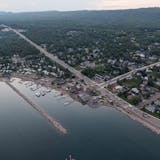A giant hidden concrete wall buried deep below the Mississippi River has been holding the storied St. Anthony Falls in place for more than 140 years. It safeguards Minneapolis' water supply and helps ensure the river doesn't undermine bridges or other infrastructure.
But the wall's condition is largely a mystery. Now some river experts and politicians are calling for a closer examination, fearing that a failure of the aging structure could prove catastrophic.
"There's a dramatic threat to the Twin Cities — water supply, upstream infrastructure, downstream navigation, billions in central riverfront development," said John Anfinson, a leading Mississippi River historian who has been calling attention to the issue. "How serious is it? We don't know."
The problem is the wall is largely inaccessible, lodged in sandstone beneath the riverbed. And it is unclear who is responsible for it; none of the entities most closely associated with the falls believes they are the owner.
Roughly the height of a three-story building, the wall helps prevent the collapse of a thick limestone riverbed slab by stopping flowing water from eroding soft sandstone underneath it. It was constructed after one of the biggest disasters in Minneapolis history, when a tunneling project went awry and nearly destroyed the falls in 1869.
There is no firm evidence that the wall, often called the cutoff wall, is in danger. But the vast majority of it can't be seen, except for an area where it intersects with old tunnels.
Anfinson has been trying to alert public officials about the issue before the U.S. Army Corps of Engineers — which built the wall — exits the area after the lock and dam closed to navigation in 2015.
The issue has piqued the interest of officials ranging from Minneapolis Mayor Jacob Frey to U.S. Rep. Ilhan Omar, both of whom want the Army Corps to conduct a closer examination.


